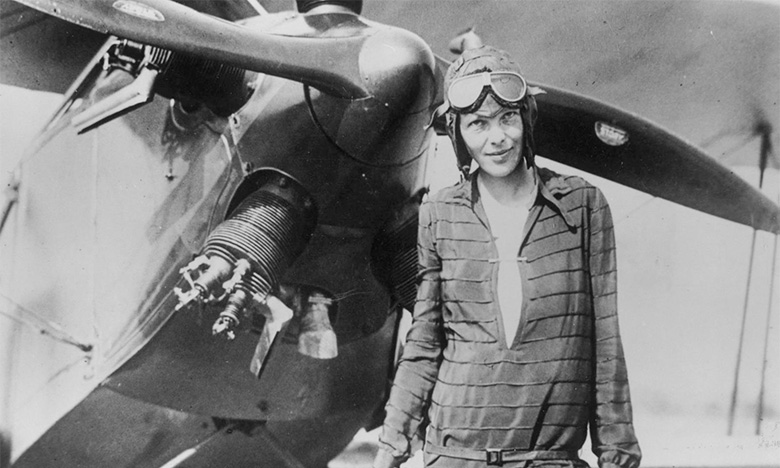Eighty years ago, on June 1, 1937, aviation legend Amelia Earhart and her navigator, Fred Noonan, set out in a twin-engine Lockheed Electra from Miami to circumnavigate the globe. That fateful journey, which would end one month later when the Electra disappeared over the Pacific, almost never happened. The 40-year-old Earhart’s first attempt to circle the globe had been aborted earlier that year when her aircraft had crashed taking off from Honolulu. But she managed to finagle more money from her sponsors to give it another go, writing at the time that in doing so, she had “more or less mortgaged the future.”
Soliciting the necessary cash to pursue her passions had, by then, become second nature to the world-famous aviatrix. In an era before celebrity endorsements were as pronounced as today, Earhart was everywhere — lecture circuits, automobile ads, magazine ads, fashion lines. Endorsements were an extremely lucrative side hustle for Earhart, and they had to be: It was the only way she could afford to fly.
Following Charles Lindbergh’s historic flight across the Atlantic in 1927, aviators like Lucky Lindy became gods on Earth, larger-than-life heroes worshipped by an adoring public and sought out by commercial sponsors to endorse their products. Earhart first flew into Americans’ hearts in 1928 as a passenger aboard the Friendship, which was piloted across the Atlantic by Wilmer Stultz and Louis Gordon. The 30-year-old from Atchison, Kansas, was hailed as “Lady Lindy,” even though Earhart said she felt more like a “sack of potatoes.” She would earn her nickname, and her place in the history books, a few years later, when she crossed the Atlantic solo, becoming the first woman, and second pilot after Lindbergh, to do so.
"EARHART COULD NOT AFFORD TO IGNORE POTENTIAL SPONSORS AND FINANCIERS."
In some ways, Earhart — photogenic, brave, savvy — was an easy heroine, becoming in 1928, as Barbara H. Schultz writes in Endorsed by Earhart: How Amelia Financed Her Flying, “America’s symbol of feminine triumph.” But in other ways, she made an unlikely icon; she was unpolished, androgynous and, above all, pragmatic, preferring, for example, to wear men’s underwear while flying because it made relieving oneself aboard a cramped plane easier. And she did not relish the newfound attention. “Today I have been receiving offers to go on the stage, appear in the movies and to accept gifts ranging from an automobile to a husband … I will be happier when the pressure of life in the public eye diminishes,” she wrote after Friendship’s voyage.
Earhart could not afford, however, to ignore potential sponsors and financiers. Fortunately, she had help from her agent and future husband, George Putnam, who marketed her image aggressively, promoting her through lecture tours and endorsements that would bolster her fame — and provide her with much-needed income. Earhart’s endorsements centered on public writings and lectures (she earned upward of $300 per speech) as well as aviation-related products, including advertisements for Mobil Oil, Pratt & Whitney aircraft and the company’s Wasp and Hornet engines. “Promoting aviation through lectures and endorsing the airlines was Earhart’s main intent,” says Schultz, a trustee for the Museum of Women Pilots. “She wanted to let the public know that the days of barnstorming were over and aviation was entering a new era.”
Still, like any good celebrity endorser, Earhart broadened her portfolio to include items she already used (or could use) during flights, from Longines timepieces to Horlicks malted milk tablets to Beech-Nut tomato juice. She also participated in several promotional gimmicks, including performing exhibition jumps for Switlik Safe-T-Chutes and cross-country piloting a Beech-Nut-branded aircraft carrying a load of the company’s chewing gum.
Earhart did not accept all endorsements that came her way — she declined, among other things, to put her face on canned rabbit — and not every endorsement was an unadulterated success. One of her first advertising campaigns was for Lucky Strike cigarettes, which were kept by Stultz and Gordon aboard the Friendship, but not used by Earhart, a nonsmoker with a squeaky-clean image. When Earhart’s picture appeared in Lucky Strike magazine ads, a public outcry ensued, and she wound up donating her $1,500 endorsement fee to Admiral Richard E. Byrd’s second Antarctic expedition.
The two products that Earhart had the biggest role in developing, and that would bear her name, were her luggage and fashion lines. With the dawn of passenger air travel, new lines of smaller luggage were needed, and Earhart thought they could be lighter and stronger if constructed using aircraft-related materials. So in 1933, the Orenstein Trunk Co. launched its Amelia Earhart line of linen- or canvas-covered suitcases with silk interiors, hailed in Vogue as “the suitcases of the future.” Later that year, Earhart launched her own fashion line. “I hate ruffles,” she told the Poughkeepsie Early News; she wanted “good lines and good materials for women who lead active lives.” Earhart personally designed the outfits, which were made from practical fabrics like parachute silk and tightly woven Grenfell cotton, and included innovations like different-size tops and bottoms and longer tails for tucking.
Earhart’s fashion line, released in the middle of the Great Depression, was short-lived, but her prolific career as a celebrity endorser proved profitable, even if time-consuming and exhausting. “Flying may not be all plain sailing,” she once mused, “but the fun of it is worth the price.”

